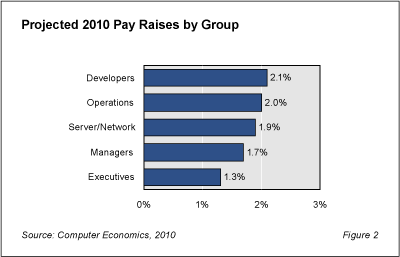During two years of turmoil, the great recession of 2008-2009 brought budget cutting and layoffs across most IT organizations, large and small. But the picture is brightening for IT workers, and our 2010 IT Salary Report finds that IT organizations are budgeting to give the typical IT worker a 1.8% boost in pay.
By historical standards, the 1.8% median pay raise is meager, as shown in Figure 1. But in light of still-high unemployment rates, the finding indicates IT executives are responding to the need to retain their best workers and boost damaged morale. Our previously published report, Outlook for IT Staffing and Spending in 2010, shows that IT organizations plan to increase operational budgets by a median 2% in 2010 and that more than one-third is planning increase staff, restoring some of the positions shed over the past two years.

That most IT workers will receive raises does not mean median total compensation will rise at the same rate, or at all. With persistent unemployment, organizations will be able to hire new workers at rates lower than those who were laid off during the recession. This should place downward pressure on U.S. national median salary levels over the coming months.
Pay Raises Start at the Bottom
Our annual salary study further finds that IT workers in the trenches are among those receiving the highest pay raises, while managers and IT executives, in that order, will get the lowest bumps. Those at the top will need to await a stronger recovery before total compensation levels will grow.
Figure 2 shows C-level executives and directors will be last in line to receive raises in 2010. This is partly because incentive pay makes up a larger portion of total compensation for executives and directors, but it is also an acknowledgement that the recession was harder on the rank and file. Managers, at 1.7%, will fare slightly better than executives fare but still receive below-average raises. As the economy improves, the executives and managers will no doubt see their compensation rise faster than the other groups.

At 2.1%, developers are receiving the highest pay raises. The developers group includes application programmers, data analysts, database administrators, business analysts, architects, and others involved in the development of new systems as well as the maintenance of existing systems.
Following close behind is the operations group, at 2.0%. The data center operations group includes computer operators, production control analysts, technical support representatives, and help desk representatives. We also include technical writers, trainers, and librarians in this group.
Also near the median is our final group of network and systems support personnel, who will receive an average raise of 1.9% at the median. This group includes network administrators, system administrators, storage administrators, security analysts, telecom analysts, and webmasters, among others.
About the Salary Report
Computer Economics has been publishing its IT salary data, in one former or another, for more than two decades. In our 2010 IT Salary Report, we project 2010 total compensation for 70 specific IT job titles in 73 U.S. metropolitan areas. The report estimates salaries at the 25th percentile, median, and 75th percentile for small organizations and for midsize/large organizations so that IT managers can use these salary schedules to understand the range of salaries offered by similar-size organizations in their geographic regions. The annual study is based on statistics collected and published the U.S. Department of Labor, which are then augmented and refined with data from our own special survey, conducted in the fourth quarter of each year, to determine median salaries, bonuses, and plans for pay raises for IT personnel.
This Research Byte is a brief excerpt from our 2010 IT Salary Report. The full report is available at no charge for Computer Economics clients, or it may be purchased by non-clients directly from our website (click for pricing).

